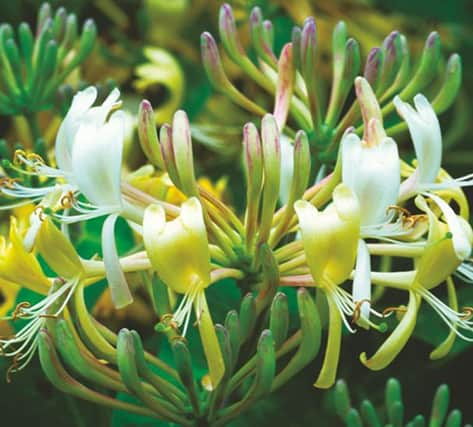Reach out and touch your garden this summer


Sensory gardens appeal to all our senses – sight, smell, sound, taste and touch – helping to reduce stress and anxiety and providing us with a place that helps encourage wellbeing and mindfulness, writes Sara Milne.
A fragrant garden is familiar to many, but in these social distancing times being able to touch and feel plants and structures is also beneficial.
Advertisement
Hide AdAdvertisement
Hide AdCreating gardens with plants and features that say ‘touch me’ encourages interaction and can also be a good way to practice mindfulness meditation.
Mindfulness concentrates your mind on the ‘here and now’ and is a proven way of dealing with mild depression or anxiety.
Focus on the what the plants feel like – not just their fragrance when touched – from leathery and lacey through to soft and smooth.
You can also mix plants that are great to touch with tactile hard landscaping elements such as a water feature, smooth polished round pebbles or the glazed ceramics.
Advertisement
Hide AdAdvertisement
Hide AdHere are some top touching plants and features to consider.
Leaves
Try Stachys byzantina, commonly known as Lambs Ear, it's soft, downy, furry silver-grey leaves area favourite amongst gardeners who tend to use it for ground cover in rich soil.
As a contrast there is Acuba japonica (Japanese laurel) which has smooth, glossy leathery leaves.
Flowers
Who can resist touching a bottlebrush Callistemon cintrinus – bundles of tiny delicate stamen flowers form a brush that’s soft to touch – or the soft paper-thin petals of a poppy Papaver orientale.
Grasses
Advertisement
Hide AdAdvertisement
Hide AdRun your hand over the arching, threadlike leaves of feathery Stipa tenuissima also known as Mexican feather grass or the more robust drought proof ornamental Festuca glauca with thread like blue foliage that forms dense mounds.
Bark
Tree bark can also provide a tactile experience especially when it’s the stunning flowering cherry Prunus serrulate with mahogany coloured bark that peels away in bands round the trunk.
Landscaping
You can easily vary the textures in your garden by choosing different hard landscaping options.
If you have smooth pebbles surrounding a water feature that you can run your hand over and through, then you could place lichen-covered rocks in another area of the garden.
Advertisement
Hide AdAdvertisement
Hide AdOur general wellbeing is intrinsically linked to the natural world which is why Thrive – the gardening for health charity – has developed the Thrive Gardening Club.
Fortnightly tips on getting the most out of your garden, whatever you age or ability, and information on how gardening can keep you healthy and feeling good are available here.
In summer, with light and longer evenings and warmer weather, it’s great to be able to relax in the garden until late.
By adding night-scented plants and soft lighting, along with pale-coloured flowers and foliage that appear to glow in the fading light, your garden will become an enticing ‘room’ to sit in at the end of the day.
Advertisement
Hide AdAdvertisement
Hide AdWhite flowering plants, like big blooms of hydrangeas, have a lovely glow in the evening garden reflecting the last of the light which makes them appear brighter than other plants.
Pale blues and lilacs also look their best in fading light, so sea holly with its tiny blue flowers that sit in rosettes of silvery-grey bracts is a great addition.
Bright foliage also creates an evening glow in the garden.
Light-coloured, variegated and silver leaf plants reflect any available light.
Lambs Ear (Stachys byzantine) is a popular ground cover plant that has the most wonderful soft, furry, silver-grey leaves.
Advertisement
Hide AdAdvertisement
Hide AdIt’s fairly drought resistant so a good choice for a dry, sunny border.
Many beautiful flowers only produce scent at night and often have a stronger aroma than their daytime counterparts.
Fragrance is released from night-scented flowers as the heat of the day lingers into the evening.
Petunias may seem be a strange choice for a night garden, but they are night scented.
Advertisement
Hide AdAdvertisement
Hide AdSome smell during the day, but not to the same intensity of the night scent.
Night Scented stocks do just that and have a pastel colour flower palate.
It’s best to plant scented night garden flowers where you’ll brush against them or come close to them.
Try planting them around doors and paths.
If you are planting in pots make sure you arrange them round seating areas to provide a heady aroma or position them near doors and windows so that the fragrance drifts inside.
Advertisement
Hide AdAdvertisement
Hide AdEven though planting the right night-flowering plants in the right place will give you stunning effects, if you want to really enjoy your garden after dark, some form of garden lighting is essential.
Try not to floodlight your entire garden.
Instead, pick out specific plants and trees to showcase.
Up lighting, either set on spikes or recessed into the ground, showcases plants beautifully at night.
But it’s not just at night time you want your garden to look good so here are some tips to keep it looking great all the time.
Hoe borders regularly to keep down weeds.
Be water-wise, especially in drought-affected areas.
Pinch out side shoots on tomatoes.
Harvest lettuce, radish, other salads and early potatoes.
Position summer hanging baskets and containers outside.
Mow lawns at least once a week.
Plant out summer bedding.
Stake tall or floppy plants.
Prune many spring-flowering shrubs.
Shade greenhouses to keep them cool.